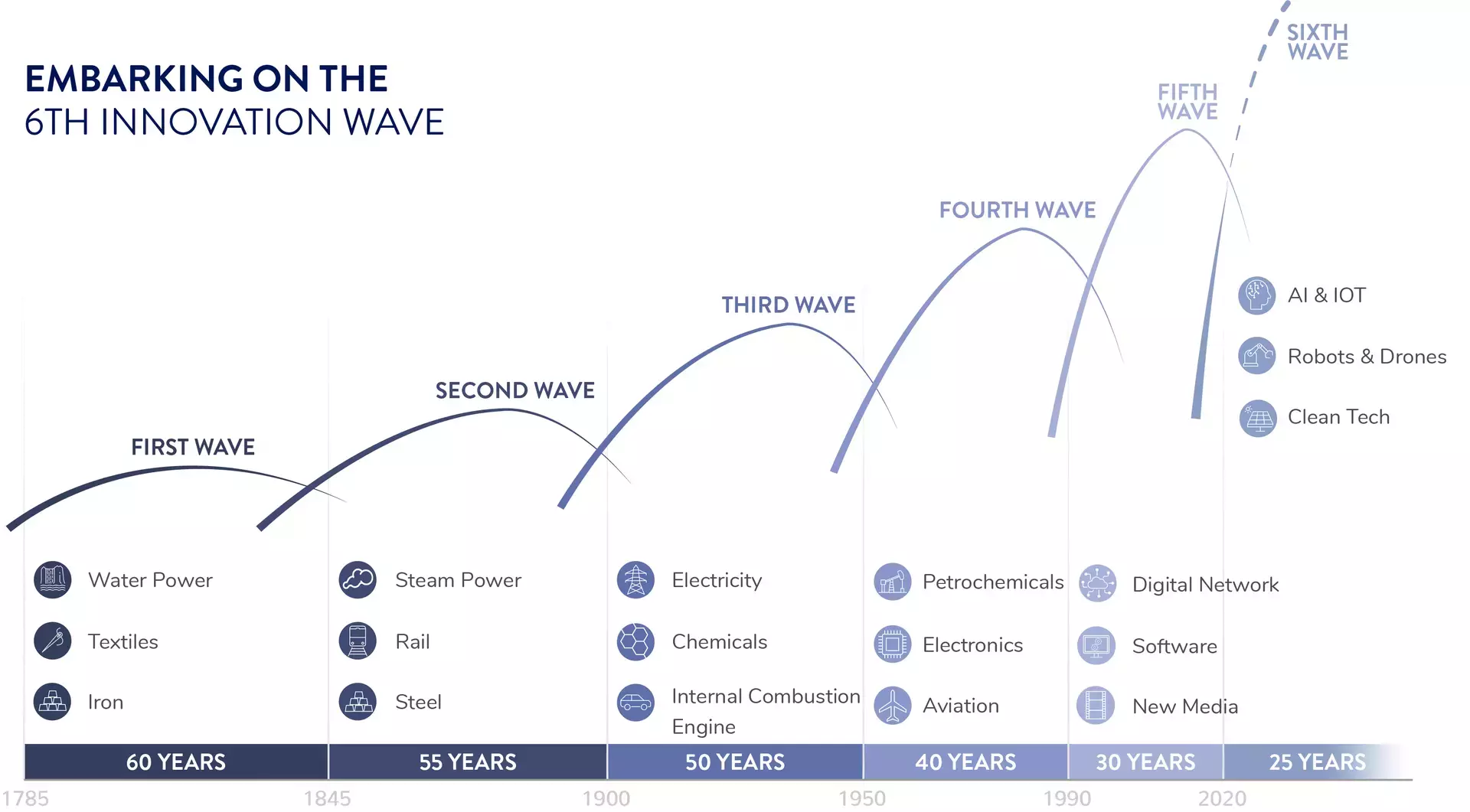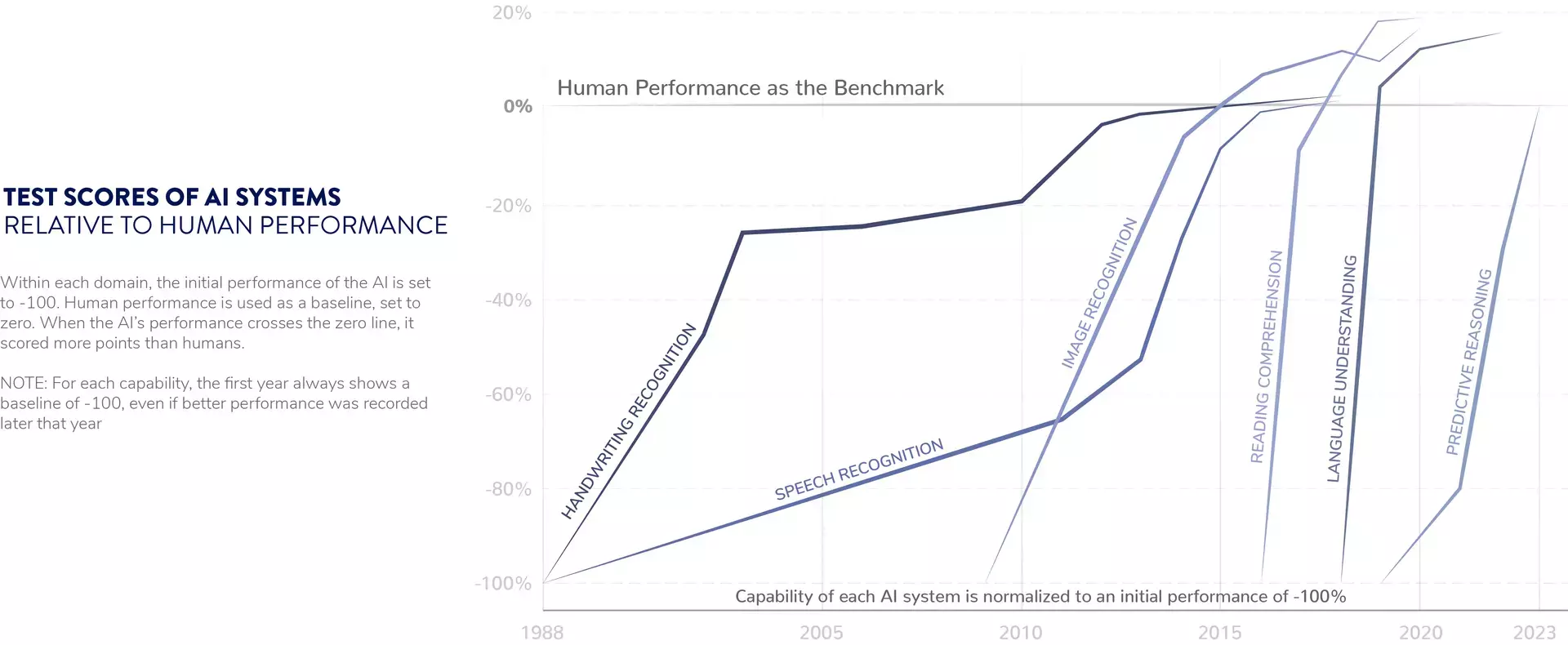Everything has changed.
“Safety is the U.S. Department of Transportation’s top priority… In 2024, the estimated number [of roadway fatalities] was a stunning 39,345. This is unacceptable,” said Secretary of Transportation, Sean Duffy.The digital, data and artificial intelligence revolutions demand that we take stock as an industry on how to raise our innovation to the level commensurate to the opportunity to save lives.
A Vision Inspires Hope
As we look to the future, we need to radically reimagine how to set the expectation for long term development in the context of generative artificial intelligence. Engineering groups designed to deal with changes over a 25-year generational period now need to adopt agile product development processes and set expectations for multiple changes in any given year.
We're currently in the sixth wave of innovation, also known as the fourth industrial revolution, which began around 2020 and is anticipated to continue until 2045, focusing on sustainable technologies like renewable energy, electric mobility and robotics. This wave is driven by advancements in digital, clean and human-centered technologies including automation, artificial intelligence (AI), sustainability initiatives and the Internet of Things (IoT). These innovations are also expected to transform products and processes by integrating machine intelligence into cognitive roles traditionally held by humans.
Within the sixth wave’s quest to enhance vehicle safety, it’s crucial to innovate at the "speed of data" by rapidly leveraging information. Achieving this requires a seamless connection between the physical and virtual worlds through sensors, simulations and analytics. The success of this approach depends on the integration of the entire system — comprising the occupant, vehicle, road infrastructure and environment.

Humanetics is at the forefront of driving safety advancements by leveraging data to accelerate improvements through both physical and virtual testing. This comprehensive approach not only adapts to varying road and environmental conditions but also considers interactions with other road users, paving the way for more accurate and effective safety solutions.
Utilizing Data for Safety Advancements
The complexity of today's safety mission also demands a system-of-systems (SoS) approach, which strategically manages complexity in organizations, particularly in digital product development, by viewing infrastructure projects as collections of interdependent systems with unique functions and connections. While these systems can operate independently, their interactions can reveal emergent properties that are crucial for optimizing overall project performance. This holistic approach fosters a new mindset for addressing challenges driven by technology, policy and economics.
With an SoS methodology, the vehicle safety industry will find value in data that enhances the accuracy of safety testing, addressing gaps in existing methods, and integrating both physical and virtual environments. This valuable data helps in refining testing processes and improving overall safety measures.
Generating data quickly also streamlines development cycles, reduces the need for redundant physical tests, and ultimately saves both resources and costs. By accelerating data collection and analysis, safety solutions can be optimized more efficiently.

Data provides critical insights into various aspects of vehicle and occupant safety, road conditions and environmental factors. Analyzing this comprehensive data enhances overall safety analytics, leading to better-informed decisions and more effective safety interventions.
At Humanetics, we employ a range of data types to drive safety innovations:
- Real-Time Test Data: Captured during physical tests to provide immediate insights.
- Simulation Data: Generated through virtual models to predict safety outcomes.
- Environmental Data: Includes information about weather, road conditions and other external factors affecting safety.
Rapid Improvement of AI
As AI and machine learning continue to advance, the quality of models is improving at an unprecedented rate. What once took decades to achieve, such as reliable handwriting recognition, is now evolving rapidly, with predictive reasoning becoming increasingly human-like within just a few years.
This accelerated progress brings both significant responsibility and remarkable possibilities. Adaptable algorithms are crucial to this rapid growth, particularly in ensuring flexible and effective safety measures. These algorithms go beyond just considering the occupant and vehicle, they also account for important factors such as road conditions, ambient variables and the actions of other road users. This versatility allows AI systems to swiftly adapt to changing real-world conditions, thereby enhancing road safety and efficiency.
Emerging Mobility Modes
 Advancements in digital data and emerging mobility modes, alongside vehicles such as Electric Vertical Takeoff and Landing (eVTOL) aircraft, are driving transformative technologies. These include dynamic algorithms capable of delivering adaptive safety systems. These systems go beyond traditional occupant and vehicle-centric approaches by integrating real-time assessments of road conditions, environmental variables, and the behaviors of other active road users. This integral approach promises enhanced safety and efficiency in the evolving landscape of transportation.
Advancements in digital data and emerging mobility modes, alongside vehicles such as Electric Vertical Takeoff and Landing (eVTOL) aircraft, are driving transformative technologies. These include dynamic algorithms capable of delivering adaptive safety systems. These systems go beyond traditional occupant and vehicle-centric approaches by integrating real-time assessments of road conditions, environmental variables, and the behaviors of other active road users. This integral approach promises enhanced safety and efficiency in the evolving landscape of transportation.
UP NEXT: Can the rapid development of new Digital tools overcome the barriers to safety innovation?
Our 'Safety as a Mission' article series covers several key topics in advancing safety technology to save lives. Click the articles below to continue reading about 'Safety as a Mission:
- Part 1: Embracing the Integrated Ecosystem
- Part 2: Our Shared Mission is to Prevent Millions from Dying
- Part 3: A Vision Inspires Hope. A Mission Demands Action
- Part 4: Equitable Design: Design for Every Body
- Part 5: Pedestrians Take a Hit
- Part 6: Next Generation ATDs & the Connected Lab
- Part 7: Welcome to the Proving Grounds: Smart Testing for Crash Prevention
- Part 8: Partnership as an Accelerator: The Agile Model of Development
- Part 9: Conclusion: Safety as a Mission: The Need for Action.
Want to Read More?
Subscribe to the Humanetics Pulse newsletter to learn more about safety as a mission and the full ecosystem.

Barney Loehnis
Barney is the President of Humanetics Sensors & Chief Marketing Officer, leading our Sensor group and marketing growth programs, strategic communications, and customer experience design. He has led marketing and digital transformations in Europe, Asia and the USA in B2B, B2C and agency sectors, for clients like IBM, VW, Huawei, Qualcomm and Mercer Consulting. Barney is a British and American citizen, a bad runner and avid cook.


